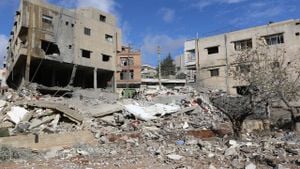Syrian rebels launched a significant offensive on Wednesday, marking the first major clash with regime forces in years. This large-scale attack has resulted in heavy casualties, with various reports citing at least 130 fatalities among combatants from both the opposition and government forces.
The offensive, named “Deterrence of Aggression,” was initiated by multiple factions including the jihadist group Hayat Tahrir al-Sham (HTS), which is linked to Al-Qaeda. According to the Syrian Observatory for Human Rights, the rebels targeted regime positions around Aleppo province, managing to capture control of Base 46, the largest military installation of the government in the region, along with 13 villages.
According to reports, troops loyal to President Bashar al-Assad have faced significant losses, with claims of 49 regime militia members and allied fighters killed amid fierce engagements. One of the more notable claims from the opposition was the precision strikes on military assets and logistical support used by the regime.
This resurgence of violence is particularly concerning, as it highlights the changing dynamics of the Syrian conflict, which has seen fluctuated engagements since the ceasefire agreement mediated by Russia and Turkey back in March 2020. Analysts believe the reactivation of hostilities reflects not only internal opposition momentum but also external influences and weakening of Assad's military strength.
Charles Lister, the director of the Middle East Institute’s Syria and Counterterrorism programs, remarked on the strategic implications of this offensive, noting, "the fact opposition forces managed to get within four or five kilometers of Aleppo is of gigantic significance." He pointed out how previous offensives of this scale would have usually been pushed back harshly by the regime forces, which seemed less capable during this engagement.
Local reports from residents indicate the intensity of clashes has caused panic, with families fleeing their homes for safety. Schools and markets have shut down as the bombardments escalate. Some rebel leaders claim the offensive serves as retaliation for recent regime artillery strikes on civilian-populated areas.
Questions are being raised about the status of Assad's allies, like Iran-backed militias and Hezbollah, who seem to be suffering setbacks due to continuous Israeli airstrikes targeting their operations. Reports mention such allies are not currently well-positioned to provide necessary support to the Syrian regime against this new wave of opposition aggression.
Further complicate the situation is the geopolitical background. The Syrian Civil War has dragged on since its inception in 2011, driven by the Assad regime's fierce suppression of pro-democracy protests. Since then, the conflict has evolved, involving multiple foreign powers and factions, leading to over 500,000 fatalities and displacing millions.
This offensive marks not only military significance but also sends ripples throughout the broader Middle Eastern geopolitics. The Kurdish-led forces, U.S. involvement, and Israel's recent military activities against Iranian-backed groups suggest Syria remains volatile.
With the situation rapidly developing, the international community watches closely as the dynamics between the opposing forces evolve. The rebel offensive may reshape negotiations and engagements on the ground, especially if the Assad regime continues to struggle against renewed rebel resolve and enhanced capabilities.



